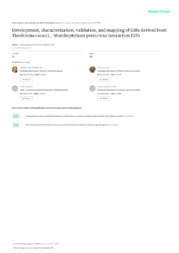Development, characterization, validation, and mapping of SSRs derived from Theobroma cacao L.?Moniliophthora perniciosa interaction ESTs.
Development, characterization, validation, and mapping of SSRs derived from Theobroma cacao L.?Moniliophthora perniciosa interaction ESTs.
Autoria: LIMA, L. S.; GRAMACHO, K. P.; PIRES, J. L.; CLEMENT, D.; LOPES, U. V.; CARELS, N.; GESTEIRA, A. da S.; GAIOTTO, F. A.; CASCARDO, J. C. de MATTOS; MICHELI, F.
Resumo: In this study, we report results of the detection and analysis of SSR markers derived of cacao?Moniliophthora perniciosa expressed sequence tags (ESTs) in relation to cacao resistance to witches? broom disease (WBD), and we compare the polymorphism of those ESTs (EST-simple sequence repeat (SSR)) with classical neutral SSR markers. A total of 3,487 ESTs was used in this investigation. SSRs were identified in 430 sequences: 277 from the resistant genotype TSH 1188 and 153 from the susceptible one Catongo, totalizing 505 EST-SSRs with three types of motifs: dinucleotides (72.1%), trinucleotides (27.3%), and tetranucleotides (0.6%). EST-SSRs were classified into 16 main categories; most of the EST-SSRs belonged to ?Unknown function? and ?No homology? categories (45.82%). A high frequency of SSRs was found in the 5?UTR and in the ORF (about 27%) and a low frequency was observed in the 3?UTR (about 8%). Forty-nine ESTSSR primers were designed and evaluated in 21 cacao accessions, 12 revealed polymorphism, having 47 alleles in total, with an average of 3.92 alleles per locus. On the other hand, the 11 genomic SSR markers revealed a total of 47 alleles, with an average of 5.22 alleles per locus. The association of EST-SSR with the genomic SSR enhanced the analysis of genetic distance among the genotypes. Among the 12 polymorphic EST-SSR markers, two were mapped on the F2 Sca 6×ICS 1 population reference for WBD resistance.
Ano de publicação: 2010
Tipo de publicação: Artigo de periódico
Unidade: Embrapa Mandioca e Fruticultura
Observações
1 - Por padrão são exibidas publicações dos últimos 20 anos. Para encontrar publicações mais antigas, configure o filtro ano de publicação, colocando o ano a partir do qual você deseja encontrar publicações. O filtro está na coluna da esquerda na busca acima.
2 - Para ler algumas publicações da Embrapa (apenas as que estão em formato ePub), é necessário ter, no celular ou computador, um desses softwares gratuitos. Sistemas Android: Google Play Livros; IOS: iBooks; Windows e Linux: software Calibre.
Acesse outras publicações
Acesse a Base de Dados da Pesquisa Agropecuária (BDPA) para consultar o acervo completo das bibliotecas da Embrapa.

